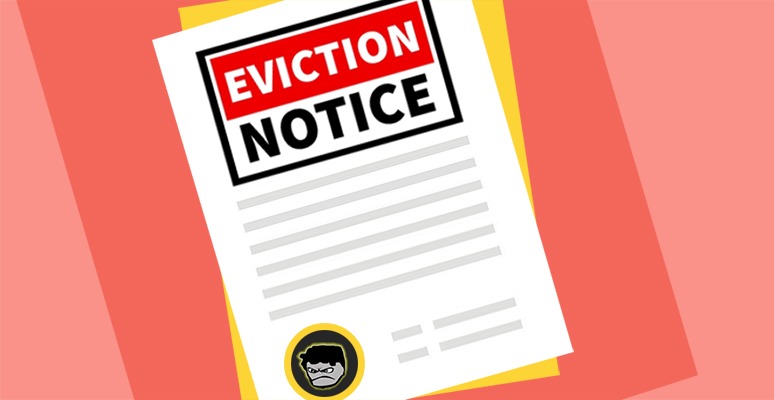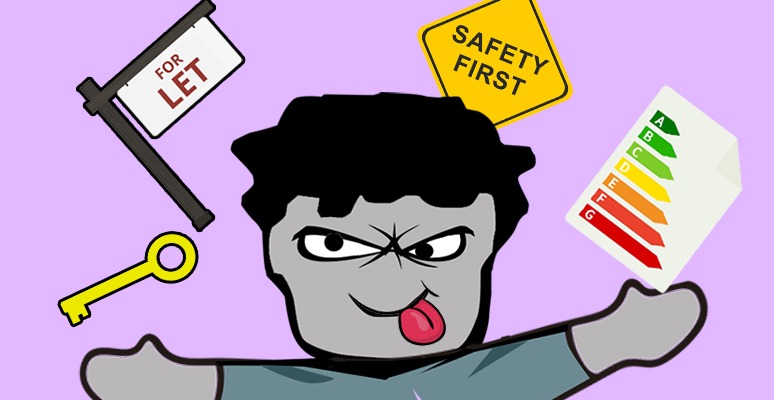
‘Fair Wear and Tear’ is not only misunderstood by many landlords, but it’s also completely unrecognised as a real concept.
Unfortunately, it is very real, and it’s important for both landlords and tenants to understand what it actually means, and how it plays a vital role in determining what damages tenants are responsible for at the end of the tenancy.
Page contents
- Final Inspections & Damages
- Fair Wear & Tear explained for Landlords
- ‘Damage’ Vs ‘Fair Wear & Tear’ in Rental Properties
- Handling Disputes with Tenants over Damage / Wear & Tear
- Landlord 10% Wear and Tear Allowance
Final Inspections & Damages
Earlier today I met my tenant for a final inspection before he handed back his keys and started a new chapter in his life without the best landlord in the world. I’m not sure how well he’ll cope, but nonetheless, good luck to him. He’ll need it.
Despite the fact we had a healthy relationship for the last 4 years, the final inspection was a dreaded affair (as it always is), because this is when everything can turn to pure shit. Not that I particularly cared, because he wasn’t going to be my tenant/responsibility by nightfall. However, it’s always easier (and often safer) to end on a good note.
But God forbid, I manage to find an issue that will require dipping into the tenant’s security deposit to rectify, because tenant’s don’t really understand it when that happens.
From my experience, if any damages are found, the tenants are generally reluctant to take responsibility. Then, when you actually make them accountable and start throwing around the phrase “deposit deduction”, they usually give you that, “are you taking the piss” look. Of course, I’m not taking the piss. The concept is simple, ‘you break it, you buy it, jackass’. Apparently a totally unreasonable principle. Go figure.
Ultimately, that’s why it’s important to compile a thorough property inventory and secure the deposit into a security scheme. It’s the best way to settle these situations fairly.
I remember a few years ago (before the tenancy deposit scheme was introduced), I had a tenant that literally smashed the front door in half. God knows how, but I imagine it had something to do with her adolescent snot-faced kids that used to run around like headless chickens. When I called her up on it during the final inspection, she played dumb, and said the door was always in that condition. Yeah, I don’t think so.

When I notified her that the cost to replace the door will come out of her deposit, she threw a hormonal hissy-fit and gave me a look that could kill. It was uncomfortable to say the least. It goes without saying, our relationship ended bitterly and the love we had one another vapourised into shit. However, she had been a tenant for 3 years, so I came to a compromise and offered to pay half. I didn’t need to do that, yet she still wasn’t appreciative in the slightest. She continued to stare me down with a gormless look on her face, like she had been slapped with a wet fish. Asshole.
Fortunately, this time round, there was no drama. I actually didn’t find anything that could be deemed as damage, or at least, taking into consideration how long he had been a faithful and well behaved tenant, I didn’t find anything that I wasn’t prepared to swallow the cost for. After most long lets, there’s usually ALWAYS something you can flag up and start querying.
Of course, this is unfortunate for you, because that means I won’t be telling you a story about how I engaged in a fuel filled battle with my tenant over his deposit, which resulted in me putting his head through a slab of concrete and pissing on him until he regained consciousness. Alas, the only touching that occurred was when we shook hands before we parted.
Fair Wear & Tear explained for Landlords
The common dilemma with final inspections is that there can be a very fine line between ‘fair wear and tear’ and ‘damage’. I’m sure most of you already know, tenants can’t be held liable for fair wear and tear. And that’s precisely why it can be such a controversial issue. While tenants will happily justify every blunder as fair wear & tear, landlords are equally as eager to chalk them up as damage. So it’s important to understand your rights, whichever position you’re in, because you don’t want to be taken advantage of.
Needless to say, it was blatant damage regarding the door scenario; there was nothing fair about it. That was a pretty black and white situation. But it’s not always so straightforward, and that’s largely down to the fact that there is nothing in law which defines ‘fair wear & tear’; the issue is simply too wide ranging. That means it’s a topic that is open to interpretation. That sounds awfully messy, right? It can be, and it often is.
But what the law does state that a tenant cannot be held responsible at the end of the tenancy for changes in a property’s condition caused by ‘reasonable use’. To quote, the House of Lords defines fair wear and tear as:
Reasonable use of the premises by the Tenant and the ordinary operation of natural forces.
Not exactly helpful, but with a bit of common sense you can take a good stab at what they mean. So, for example, carpets naturally wear overtime with normal use, which means landlords can’t force tenants to replace the carpets to their original state if they show signs of usage, because the condition constitutes as ‘fair wear & tear’.
However, if there are gaping big holes in the carpet and/or cigarette burns that weren’t originally there, it’s safe to define it as damage, consequently the tenant can be held responsible for covering the costs for the repair. Similarly, scuffs and scraps on the walls are typically deemed as fair wear & tear. However, smeared baby-poop and holes that you can put your penis through are not.
‘Damage’ Vs ‘Fair Wear & Tear’ in Rental Properties
Personally, I believe a lot of it does boil down to common sense. But obviously we can’t always rely on people to own any of that, and there lies the root of the problem. However, here are a list of things landlords should make allowances for when deciding whether or not something is ‘fair wear & tear’:
- The original age, quality and condition of any item at commencement of the tenancy: consider the quality of the property itself. Many new builds are dogshit, they aren’t quite as robust or well-built as older properties. Walls and partitions are notoriously thinner and consequently, likely to suffer more stress. This typically means there is a greater need for redecoration at the end of a tenancy.
- The reasonable expected usage of such an item: Bear in mind, nothing lasts forever, and every item has an expire date. So if a washing machine packs up after 10 years of good service, it’s fair to say it’s lived it’s expected life, and it would be unnecessary to claim against the tenant, even if there are signs of abuse.
- The number and type of occupants in the property: The more tenants in a property, the higher the wear and tear, particularly in shared areas, such as the kitchen, stairway, sitting room, dining room etc.
Scuffs and scrapes are unavoidable in normal family life. A property occupied by a single person will see far less wear than a family of four, so bear this in mind when it’s time for tenants to leave.
- The length of the tenants’ occupancy (I took this into consideration when I decided to pay half for the door): The longer the tenancy, the more natural wear. Common sense.
In many cases, I’m quite forgiving when it comes to long-term tenants vacating. If they have paid rent on time, and been generally well behaved, I don’t think it’s necessary to call them up on every small issue that can be deemed as ‘damage’. For example, this includes broken door handles, other small fixtures, and overgrown/abused gardens. My advise is to consider the value they have given you other the years, and repay them with a degree of lenience. Of course, it’s your call, and theoretically, you could be shrewd as you are ugly, and go after every last penny.
Legally, a landlord should not become in a better position materially than they were at the start of the tenancy. That means a landlord is not entitled to charge their tenants the full cost for having any part of their property, or any fixture or fitting “put back to the condition it was at the start of the tenancy.” without taking into consideration fair wear and tear. Because this would constitute betterment. Essentially, a tenant’s deposit is not to be used like an insurance policy where you might get ‘full replacement value’.
Therefore, appropriate remedies available to the landlord might range from:
- Replacement of the damaged item where it is either severely and extensively damaged beyond economic repair or, its condition makes it unusable
- Repair or cleaning
- Compensation for diminution in inherent value of the item or the shortening of its useful normal lifespan
How to Prevent Damage & Wear and Tear in your BTL
It goes without saying, the best solution is to avoid damage and wear & tear, or at least minimise it. That’s crucial, because it will avoid a lot of escalating emotions, potential violence, and spending.
Due to the nature of this business, it’s virtually impossible to prevent damage and wear & tear altogether; we’re dealing with real life people that have functioning body parts and live normal lives (with the odd exception), so it happens. However, there are certain best practices to help keep it to a minimum.
- Decorate sensibly, not like an idiot: I’ve discussed this in detail already, but the general premise is to decorate your property for what it is, a buy-to-let property, and not a showroom that will be housing cuddly toys.
The key is to avoid cheap, flimsy fittings, no matter how tempting it is, because you’ll be forever replacing them. Focus on durability, which entails using robust carpets, appropriate paint colours, and quality appliances. Here’s a more detailed article on Decorating/Renovation Tips For Buy-To-Let Properties & Landlords.
- Be a good landlord: keep tenants happy by being a good landlord, that way they’ll think twice before moving, and they’re more likely to treat your property like a home. This will involve, attending to repairs and maintenance issues in appropriate time, being contactable and responsive, and being understanding when rent is late (assuming it doesn’t happen frequently). It doesn’t hurt to improve living conditions now and then either, like applying a lick of paint, for example.
Reducing your tenant turnover means that you will not be redecorating/renewing the property as frequently as you would for shorter tenancies.
- Inspections: this is absolutely imperative, yet so many landlords fail to do it because they don’t want to get off their asses. Shameful.
Making regular landlord property inspections (e.g. every quarter) is the best way to identity and squash any aspiring problems at the early stages so they don’t escalate into serious problems.
- Set your expectations from the start: ensure your tenants are aware of what you expect from them, which is to keep the property well maintained and clean.
- Protect yourself: while protection against wear and tear is vital, it’s also equally important to ensure that you have covered all bases in the event of a dispute with your tenant over the return of the deposit.
The best way to do that, as already said, is to compile a thorough inventory and protect the tenant’s deposit (the latter being the landlord’s legal requirement).
Handling Disputes with Tenants over Damage / Wear & Tear
Disputes over deposits and damages isn’t uncommon. In fact, it happens a shitload.
First, let’s quickly take a look at the legislation. The Housing Act Schedule 10, which covers the tenancy deposit legislation, makes it clear that “fair and wear” can’t be deducted from the deposit:
(5)The amount claimed must be referable to –
(a)an amount of unpaid rent or any other sum due under the terms of the tenancy; or
(b)a liability of the tenant to the landlord arising under or in connection with the tenancy in respect of –
(i)damage to the premises subject to the tenancy, or
(ii)loss of or damage to property on those premises,
other than damage caused by fair wear and tear.
I’m a firm believer in compromising, and that should always be the first approach when dealing with disputes. Sit down and rationally try to come up with an agreement that all parties are happy with. This may often involve splitting costs, and taking some financial hits, but it’s definitely the best outcome. Prolonging these issues and taking matters further can usually do more harm than good.
Of course, this is real life, annoying shit happens, so often these issues don’t get dealt with rationally. And that’s precisely why it became compulsory for landlords to secure tenants’ deposits into a tenancy deposit scheme. That means, if there are any disputes that can’t be dealt with in-house (between the landlord and tenant), the case can get passed over and handled by the scheme’s independent adjudicator.
If you’re in that position, whether you’re a landlord or a tenant, you should notify the scheme the deposit is protected with. They will then assess the case and decide the outcome. It’s important to note, they will only assess the case based on the evidence provided. Again, this is why an inventory is so crucial. If you can’t prove your position, you won’t have an integrable case (particularly for landlords).
Over at The Dispute Service (TDS) website, there’s a library of case studies, which explains how the TDS adjudicator reached their decision on various disputes. They also discuss the best way to present a case. So, if you’re in the middle of a dispute, it’s worth finding a case relevant to yours, and looking over the notes to assess your chances and to determine the best way to strengthen your case.
Landlord 10% Wear and Tear Allowance
I just want to end on this final note, because it might be relevant and useful for those currently unaware!
If you’re renting out a fully furnished property, you can take advantage of a 10% wear and tear allowance. This does NOT apply to part-furnished rentals. The allowance covers items that a landlord would typically provide in furnished accommodation, such as: beds, freezers, cookers, curtains, carpets, sofas etc.
The deduction is calculated pretty simply. All you need to do is deduct 10% from the net rent. The 10% wear and tear allowance is claimed on the property supplementary pages of the self-assessment tax return, in box 34 of page SA105 (Income from UK property). For more details about this allowance, go to the HMRC website.
Update (6th April 2016): as of today, the 10% wear and tear tax allowance has been abolished! Landlords can now only reclaim what they have spent.
Yup, everyone say “BOOOOOOOO!”
So, has anyone had any experience with disputes regarding damages and/or wear and tear, from either a tenant’s, agents or landlord’s perspective? Would be interesting to hear your story, along with any additional tips/advice you have to offer!
Disclaimer: I'm just a landlord blogger; I'm 100% not qualified to give legal or financial advice. I'm a doofus. Any information I share is my unqualified opinion, and should never be construed as professional legal or financial advice. You should definitely get advice from a qualified professional for any legal or financial matters. For more information, please read my full disclaimer.


 Landlord Products / Services
Landlord Products / Services






























really useful, common sense information. Too many landlords take the mick and get away with it as tenants don't know their rights and it makes tenants miss trust all of us.